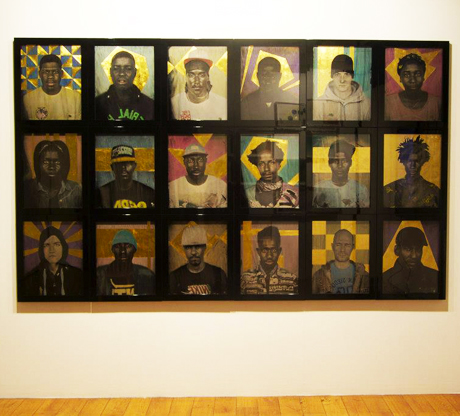Fathom – experiments in film and photography

Iconostatus, Waler Hugo: hand coloured tintypes / 24ct gold
In Fathom: Soundings from Artists in Residence, three London-based artists explore themes of subjectivity, visibility and constructed identity.
Since June 2012, David Birkin, Walter Hugo and Tess Hurrell have been developing new works of art using the production facilities at the Four Corners film and photography centre.
The three artists were selected from over 150 applications to be part of Four Corners’ inaugural artists in residence program, supported by the National Lottery through Arts Council England.
Development Director, Carla Mitchell said: “We invited artists to take an innovative approach towards our facilities and to test out new practices.”
One of those new practices, and arguably the most striking piece in the exhibit, is Walter Hugo’s Iconostatus where antiquarian techniques produced one-off street photography.
Hugo photographed East London youth, ranging from ex-prisoners and drug dealers to stylists and DJ’s – young people you might usually avoid eye contact with on the street, but who now hold your full attention in a captivating display of 18 portraits.
Hugo uses long forgotten and raw techniques to produce the images, like elongated exposure and a tintype process. After taking the photos, Hugo painstakingly painted on 20-50 layers of gold leaf, lessening the severity of the subjects, and evoking a spiritual sentiment.
Indeed, the title of the work, ‘Iconostatus’ plays on the word iconostasis, meaning a wall of religious paintings or icons, typically seen in Russian Orthodox churches. Hugo explains how he was fascinated with the idea of turning everyday people into beautiful icons, and by doing so he has removed some of the stigma that is so often associated with East London youth.
Next to Hugo’s work is a video by artist David Birkin, who usually works with photography. Here he has produced a thirty-minute split-screen film piece, studying the process of shedding and constructing an identity.
One half shows an actor, taking the role of a soldier describing how his tour in Iraq affected him and his return to civilian life, while the other screen shows a real soldier methodically taking off his uniform and cleaning his equipment. While the work is interesting, at 30 minutes it feels a little long and with only one viewer able to sit at any one time, it doesn’t lend itself to a shared experience.
In the adjoining space, Tess Hurrell explores ideas of movement and photography using Hackney’s canals. It was while Hurrell was cycling to the studio that she became fascinated with Hackney’s waterways. She took over 200 still images which she then converted into 16mm film stock.
The photographs themselves are abstract, and like Hugo’s piece imperfections are embraced rather than discarded. However, it’s only when you see the images projected in an edited sequence that you fully understand her artifice – the idea of light, movement, and reflection, a kind of dreamy journey through Hackney’s waterways.
Mitchell said: “The residency programme has been a new learning experience for Four Corners, and we are delighted by the variety and inventiveness of the work.” She added that they hope to continue the programme in future years, dependent on finances – here’s hoping the funding continues.
Fathom: soundings from artists in residence
Four Corners Film
Until 15 February 2013
121 Roman Road
E2 0QN
020 8981 6111
